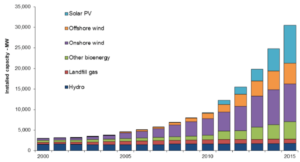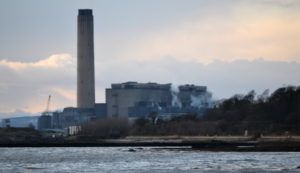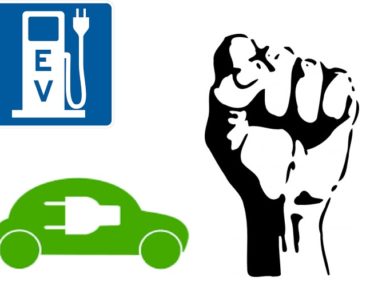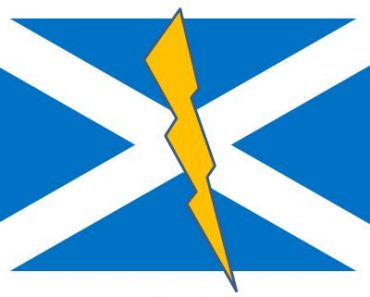Contents
The UK is one of the top economies of the world and as of 2016 stands fifth in the list of the countries with the highest GBP . When it comes to renewable energy capacity though, the UK stands at 8th position. This level is seemingly modest and some people would argue that it is healthy. However, when one looks at the countries that have far greater share of renewables in their energy mix, with far little resources, than the current position becomes questionable.
It is not just the monetary resources that UK has in abundance but also the Renewable resources. It has been ascertained by many independent studies that the UK is one of the best location in the world for using renewable energy. It has the best wind resource and wave/tidal potential in Europe. And yet when it comes to exploiting the renewable energy resources, the Kingdom lacks the drive.
North Sea Oil discovery in 1969 instilled a habit that is hard to break. From the 60’s onward, Western Europe started looking into efficiency measures to make their fuel supplies last longer. The UK on the other hand lumbered on with their existing inefficient infrastructure. The complacency stemmed from the Oil boom (from 1980 to 1990s), when production peaked at 4 million barrels a day.
To this day, the UK has one leg firmly rooted in the North Sea oil venture. Progress towards renewables therefore has become a step to far. With the current supplies from the North Sea less than a quarter from its peak years, and with the closure of old coal fired/ Nuclear power plant on the horizon, the UK is staring into the abyss of an Energy Gap.
This article looks at some of the policy mistakes that have hindered renewable energy progress and hurt emission targets.
Lack of District Heating infrastructure
Coal has been the fuel of choice for the UK particularly with its rich mining heritage and the scepticism over nuclear power. The use of coal has also been heavy in several western European countries. However with district heating infrastructure in place, coal can be used with double and even triple the efficiency. Britain unlike their neighbours across the channel has not developed district heating infrastructure.
It is known that electricity produced by a simple Rankine cycle amounts to only 33% percent of the energy in fuel (mostly coal). The remaining 67% is given off as heat. If this heat energy is utilized than the overall process efficiency (utilizable energy/ energy in fuel) can reach over 98%. Such systems exists and are called CHP or Combined Heat and Power systems. In Holland and Norway for example, power plants supply both electricity and heat to their local communities. Most western European power-plants are a lot smaller compared to large centralized power stations in England. Having several small power plants as opposed to few large ones also creates a more robust and reliable overall system.
In the UK, old coal fired power plants barely reach process efficiencies over 35%. The remaining 65% energy in the form of heat is wasted by dumping it in nearby rivers/sea. Lack of district heating network does not allow the heat generated by the process to be shared even with the local communities.
Poor ROCs enforcement
Renewable Obligation Certificates or ROC was a scheme designed to encourage energy suppliers to source a greater portion of their energy from renewables. The scheme was introduced in April 2002 and the initial target was set at 3%. Meaning suppliers were required to have at least 3% of their energy driven from renewables in the year 2002.
The idea was to gradually increase the target (adding 1% every year) till in 2015/2106 it reaches the value of 15%. The mechanism had the right principal at its core but its implementation had a lot more to be desired. There were two weaknesses in the system. Firstly the energy suppliers resisted the idea and put pressure on the government consistently to lower renewable obligation target. Any counter measure to avert this resistance was not implemented. As a result, the UK as a whole in 2015 had only 8.3% energy from renewables instead of 15% that was initially planned. Secondly the financial penalty that the supplier had to bear for the shortfall was passed on to the customers. Again there was no mechanism in place to stop this activity.
One of the biggest problems confronting the UK is that only 6 suppliers have the majority share (95%) of the household electricity and gas market. Known as the big six these energy suppliers often act collectively to further their interest. While any collusion among these corporations cannot be said with certainty, but they are united in vehement opposition of the ROC scheme. The penalty that resulted because of their lack of progress was unfairly passed on to the end user instead of being absorbed by themselves.
Lack of Community Engagement
The introduction of Renewable Energy was met with resistance by several communities. There was a wide range of concerns. People employed by the fossil fuel power sector or working in the oil industry saw renewables as a threat to their livelihoods. Some people viewed wind turbines as towering monstrosities that would impact tourism negatively. Their concerns were amplified by influential people and right wing politicians including the likes of Donald Trump.
Programs that would educate the local community on the benefits of renewables were far and few between. In Scandinavia and particularly in Denmark, the attitudes towards renewables are extremely positive. The community ownership schemes for wind farms were introduced early and the monetary benefits of green energy generation were shared. The opposite was true in the UK where the penalty of not meeting renewable target was shared with the consumers. Despite a recent study that shows that wind turbines do not impact tourism, the negativity still surrounds renewables among many communities in the UK. This unrest within communities lead David Cameron to make the comment “Enough is Enough” in reference to onshore Wind Turbines.
Late introduction of Renewable Heat Incentive (RHI)
While Feed In Tariffs for renewable electricity were introduced as early as 2008, similar incentive for renewable heat were introduced much later. After much deliberation, the UK government finally announced RHI on 9th April 2014 for the domestic sector. Even the non-domestic RHI was introduced in 2011 despite their foundation laid in the Energy Act 2008 . Although the scheme covered a wide range of technologies but the incentives were almost entirely paid on Bio-mass boilers. Innovation in renewable thermal technologies that would have been spurred had RHI been introduced earlier is almost non existent today in Britain.
Lack of Ambition on Nuclear Reprocessing
It is widely known fact that nuclear fuel rods are discarded even when they still have 95% of fissile nuclear material left in them. This fissile material in the waste fuel rods is either reprocessed for weapons or stored securely till it degrades. In the UK, the storage of waste nuclear fuel is carried out in Sellafield. There is also a third option which allows the reprocessing of nuclear waste as Mixed Oxide Fuel or MOX. This fuels can be used in thermal reactors but is more efficiently utilized in Fast reactor.
A Thermal Oxide Reprocessing Plan THORP is already operation in Sellafield. The plant is reclaiming fuel from nuclear waste but is due to close in 2018 after fulfilling its contracts. Experts have suggested that funding cuts in 1998 to nuclear reprocessing research have impacted negatively on this industry. As a result, knowledge and capacity of nuclear reprocessing in UK is extremely limited. The waste stocks in Sellafield have surpassed 292000 cubic meters and are increasing. These also include foreign nuclear waste. Storing the waste fuel away for hundreds of years is obviously not an option. Robust plan must be chalked out to resolve this issue and research funding for reprocessing should be a top priority.
Pulling the plug on Carbon Capture and Storage (CCS)
Carbon Sequestration is an ideal solution for curtailing emissions (by 90%) particularly for countries with access to depleted oil fields. The idea is to capture CO2 emanating from the chimney of a fossil fuel power plant (coal in particular) by means of a chemical process. The gas is than separated and pumped into a gas/oilfield to be stored underground. Notable portion of energy is used up in the process of reclaiming and shipping CO2.
In the UK, CSS system was tested in Longannet Scotland, ahead of many other countries. The scheme was abandoned however in October 2011 due to lack of government support. This was an unfortunate decision as three years later (in October 2014) SaskPower’s Boundary Dam Power Station in Saskatchewan, Canada, became the world’s first commercial-scale CCUS power plant. Several other power plants in US have followed suit.
The current cost of storage per tonne of CO2 stands at £50 – £ 75 (€60 -€ 90) but is likely to drop at least 2 folds in the 2020s. Had the funding continued, UK would not only been sequestering carbon from its huge coal fired power plants but would also have been selling CCS expertise to a wide range of countries.
Investment in wrong technology
When travelling across the UK on a railway, one finds Darrieus (vertical axis) turbines on the roof top of every Network Rail car park building. These turbines are seen static almost all the time even when their horizontal axis counterparts are rotating at top speed. The Darius turbines are not self starting and require external force to get them going.
The UK did not vet renewable technologies before investing in some of them. In the case of network rail, commercially proven technology was overlooked in favour of aesthetics. Similarly grants were made available for micro wind turbines, even when it was known that the technology does not work at small scale.
Any investment on a certain renewable technology that does not pay-off reflects badly on the overall sector. Renewables got more than its fair share of bad press because of these faulty investment decisions.
Final Word
The UK government’s skepticism on Renewables is in sharp contrast to Germany’s Energiewende policy which is now bearing fruit. Germany has already achieved 27% reduction in the baseline (1990) emission levels and produces 30% of its energy through renewables. The renewable sector in Germany has also created over a million jobs. The reduction in Feed In Tariffs has also hit the Renewable industry hard.
In addition, Wave power technology that was pioneered in UK (Edinburgh University, 1974) was at the verge of commercialization when its funding was slashed. The country never viewed renewable energy technology as a wealth generation / job creation opportunity. The net result is that the Kyoto target of 50% reduction in the year 2050 is becoming extremely hard to achieve. Furthermore, the UK and in particular England is is more reliant on imported electricity today than it ever was.
Please feel free to share this article using the buttons below
Also worth reading









